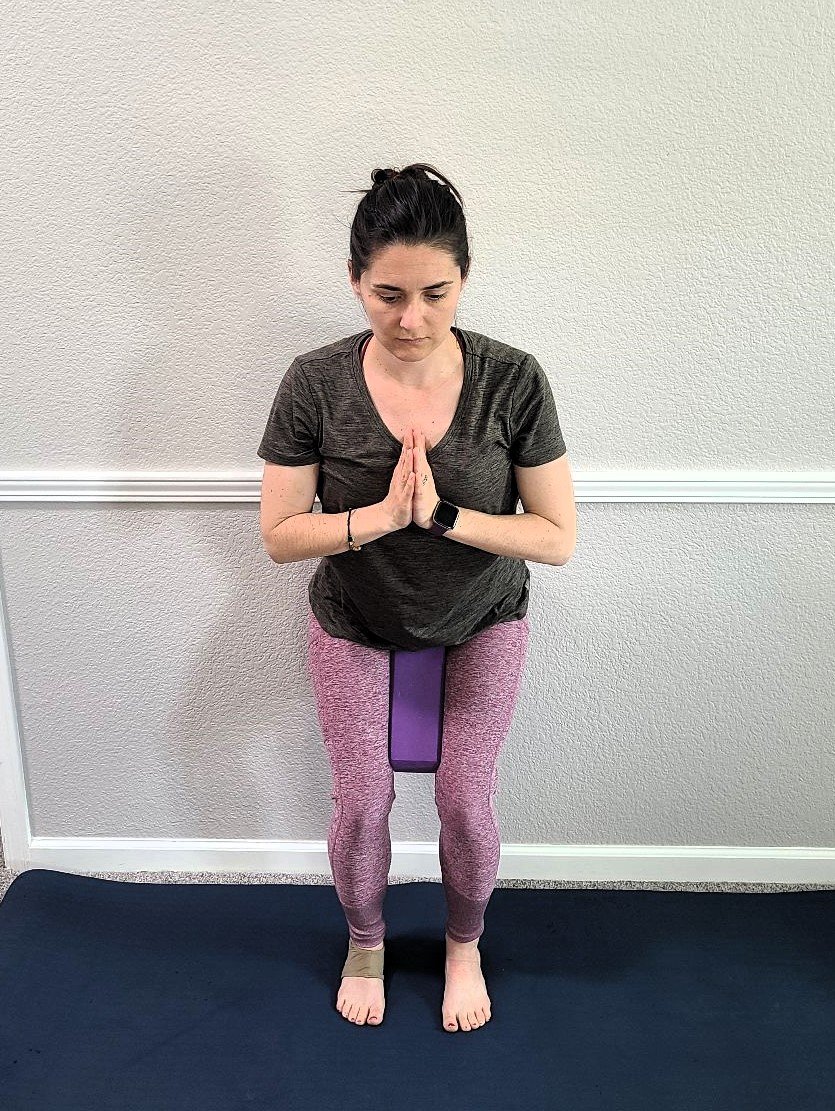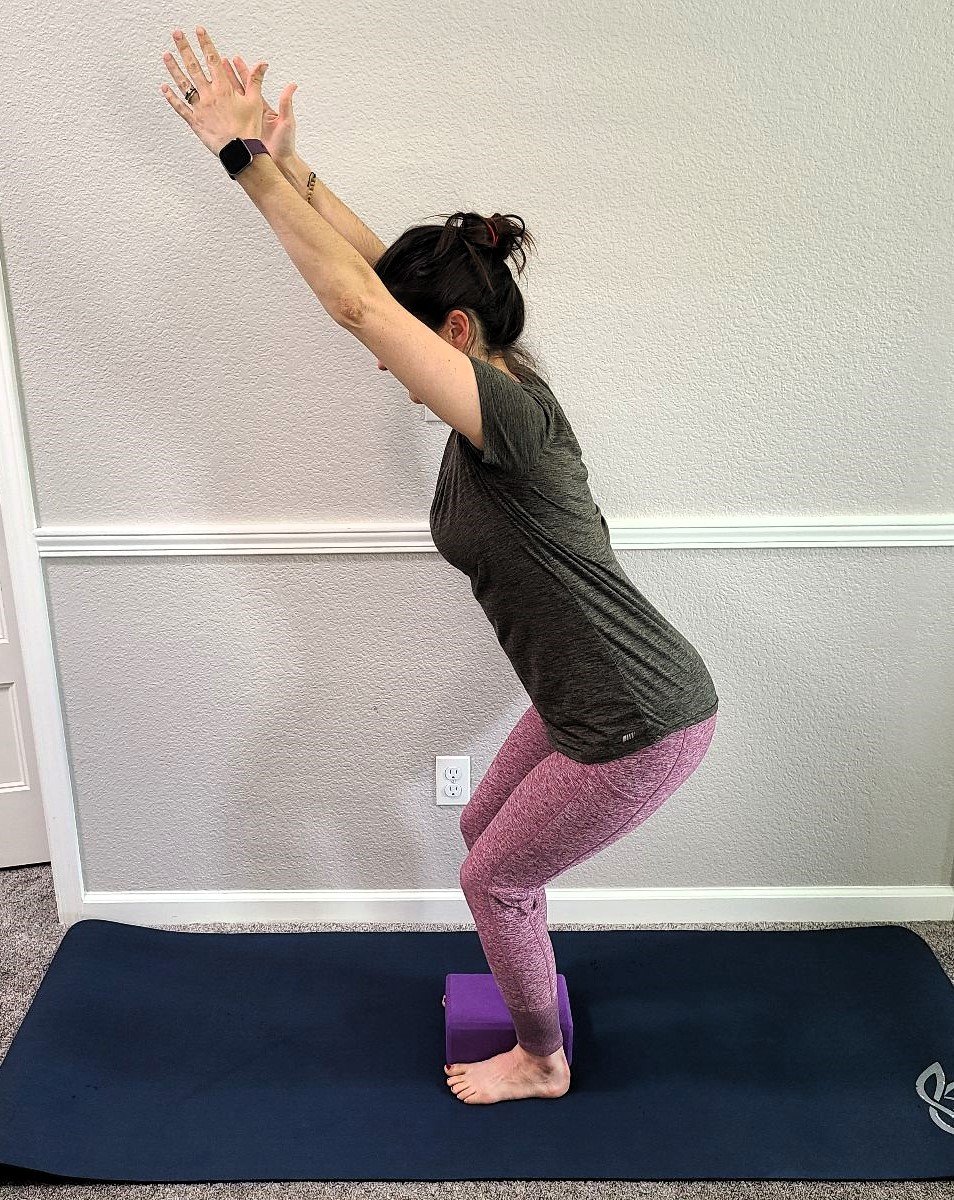Yoga Pose for Leg Length Discrepancy: Chair Pose (Utkatasana)
/Chair Pose (Utkatasana) is a fantastic yoga pose for strengthening legs, core, and improving balance. As a symmetrical standing yoga pose, it can be uncomfortable for those with leg length discrepancies because their bodies aren’t naturally symmetrical or aligned. However, this misalignment makes the pose a beneficial one to practice. It allows you to notice differences between your sides and try to create more balance and levelness between them.
How to Do It
Begin in Mountain Pose (Tadasana) with your feet hip-width apart (or together), toes pointing forward, and weight evenly distributed on both feet.
Engage your core by drawing your lower abdominals in and up.
Breathe in and raise your arms overhead, reaching through your fingertips. Keep your shoulders relaxed and shoulder blades drawn down. You can also keep your hands on your hips, together in prayer position in front of your heart, or holding a chair or wall for additional support.
Exhale as you bend your knees, pushing your hips back as if sitting down on a chair. Keep your knees relatively aligned over your ankles and tracking with your second or third toes. Fight the tendency to drop your knees forward beyond your toes or for your knees to cave inward.
Lengthen your spine from your tailbone to the crown your head; limit your chest from rounding forward by broadening the collarbones and keeping your shoulder blades down.
Often this pose is done with the thighs parallel to the ground and knees at a 90-degree angle. This isn’t necessary. Find the depth that allows you to keep appropriate alignment in your ankles, knees, and hips.
Evenly balance your weight across and between your feet—that is, distribute weight evenly between each foot and also across the fronts, backs, and sides of the feet.
Stay for 5 to 10 breaths before straightening your legs and lowering your arms.
Use Props for More Support
Especially if you have lower back or SI joint pain, it helps to do Chair Pose using props. Try squeezing a block in between your thighs. This helps strengthen and stabilize the legs and hips, which supports and provides a foundation for the lower back. You can also increase your stability by bringing your feet hip-width apart and placing a block in between them to improve alignment from your feet to your hips.
If you need additional help with balance stand in front of a wall or chair to place your hands on. This allows you to focus more on alignment and less on balance, which can be useful with body asymmetries.
Also, you can do Chair Pose facing away from the wall with your sitting bones pressing into it. Try to press evenly into each side to level your hips from front to back. Alternatively, press your whole back into the wall and feel for asymmetries in your back and hips; try to press evenly into the wall on both sides and notice if the hips are level.
Notes for the Shorter Leg
Make sure to wear a lift or have a prop (like a folded towel or blanket) under the foot of the shorter leg to help level the hips. Activate the quadricep (front of the thigh) and lift it up toward the hip. Doing so will gently lift that lower leg hip.
Notes for the Longer Leg
Often the shorter leg bears more weight when standing or squatting, so this pose is an excellent opportunity to strengthen the longer leg. This might include shifting a little extra weight onto your longer leg or pressing down a little more into that foot.
Things to Watch For
Try placing your hands on your hips in this pose to feel their fronts, sides, and backs. Compare each side and try to make them more level. Is one hip higher or more forward? In addition to trying to find alignment through your legs with the methods mentioned above, engage your lower abdominals and see if you can use the muscles of your pelvic floor to find more evenness.
If you feel pinching in your lower back, reduce the intensity and range of motion until you find a position that doesn’t hurt. The focus here is on finding stability and alignment, not depth.
This pose is suitable for most people, especially if they work within their individual needs and body’s anatomy. But if you have any concerns with how your joints feel in this pose, make sure to reach out to your medical provider and a qualified yoga instructor.




